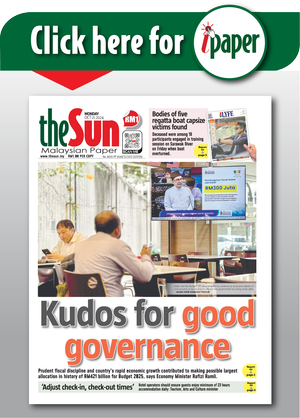KUALA LUMPUR: BMI, a unit of Fitch Solutions, has retained its forecast that Malaysia’s federal government budget deficit will narrow to 3.8 per cent of gross domestic product (GDP) in 2025, down from 4.1 per cent in 2024.
In a research note today, BMI said that it remained comfortable with its projection, given the current administration’s track record of sticking closely to its fiscal targets and its alignment with the Malaysian government’s own projection.
“The budget also marks a positive step towards Malaysia’s medium-term goal of narrowing its budget deficit to an average of 3.5 per cent between 2025 and 2027,” it noted.
The Malaysian government is pushing ahead with fiscal consolidation and is targeting a 3.8 per cent deficit of GDP in 2025. A key driver of this reduction is the ongoing broadening of the tax base, while the the government continues to rein in spending.
However, BMI warned that risks to the forecasts are weighted towards a larger deficit, as US President Donald Trump’s administration has recently imposed a 24 per cent reciprocal tariff on all Malaysian imports into the US, which could have a significant impact on Malaysia’s export-oriented economy.
“The silver lining, we think, will depend on the degree of success attained when both sides engage in negotiations to bring down the tariffs,” BMI said.
BMI also forecasts a slight slowdown in revenue growth, projecting it to decline to 16.3 per cent of GDP in 2025 from 16.6 per cent in 2024.
It noted that the most significant budget announcements include the expansion of sales and services tax (SST) to include business-to-business (B2B) commercial service transactions, non-essential food items, and imported premium products like salmon and avocado.
BMI estimated that these measures could generate RM51.7 billion in revenue, or 2.2 per cent of GDP, which the government plans to use to offset declining petroleum-related income.
“Indeed, while petroleum-related revenue will probably ease to three per cent of GDP in 2025 from 3.2 per cent in 2024, based on the government’s revised oil price forecast of US$75-US$80 per barrel in 2025, it fits into policymakers’ goal of reducing its reliance on petroleum-related income.
“We also expect the government to meet its revenue targets, as it has consistently done in recent years, through the imposition of a two per cent tax on individual dividend incomes exceeding RM100,000 from the year of assessment 2025,” BMI said.
While BMI anticipates that total expenditure may exceed budgeted levels, it acknowledges that the gap between budgeted and actual spending has been narrowing since 2022, with total expenditure expected to decline to 20.1 per cent of GDP in 2025 from 20.9 per cent in 2024.
“The upside, we think, is policymakers’ intention to cut back on existing blanket RON95 subsidies effective mid-2025 and to roll back education and healthcare subsidies for the top 15 per cent income group.
“While the withdrawal of RON95 petrol subsidies will translate into approximately RM20.0 billion in savings, details surrounding the plan remain scant, raising questions about its implementation and effectiveness within Malaysia’s fiscal consolidation efforts,” it added.
BMI forecast that total government debt would remain elevated at around 63 per cent of GDP, as it rose to RM1.23 trillion at end-2024 from RM1.17 trillion at end-2023.
It noted that Malaysia’s public debt levels remain relatively high compared to its emerging market peers, but fiscal risks are expected to remain contained, not least because more than 97 per cent of total debt is in ringgit-denominated securities.









